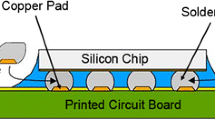Abstract
Taking the most promising substitute of the Sn-3.8Ag-0.7Cu solder as the research base, investigations were made to explore the effect of rare earths (REs) on the creep performance of the Sn-3.8Ag-0.7Cu solder joints. The SnAgCu-0.1RE solder with the longest creep-rupture life was selected for subsequent research. Creep strain tests were conducted on Sn-3.8Ag-0.7Cu and SnAgCu-0.1RE solder joints in the intermediate temperature range from 298 K to 398 K, corresponding to the homologous temperatures η=0.606, 0.687, 0.748, and 0.809 and η = 0.602, 0.683, 0.743, and 0.804, respectively, to acquire the relevant creep parameters, such as stress exponent and activation energy, which characterize the creep mechanisms. The final creep constitutive equations for Sn-3.8Ag-0.7Cu and SnAgCu-0.1RE solder joints were established, demonstrating the dependence of steady-state creep rate on stress and temperature. By correcting the apparent creep-activation energy of Sn-3.8Ag-0.7Cu and SnAgCu-0.1RE solder joints from the experiments, the true creep-activation energy is obtained. Results indicated that at low stress, the true creep-activation energy of Sn-3.8Ag-0.7Cu and SnAgCu-0.1RE solder joints is close to the lattice self-diffusion activation energy, so the steady-state creep rates of these two solder joints are both dominated by the rate of lattice self-diffusion. While at high stress, the true creep-activation energy of Sn-3.8Ag-0.7Cu and SnAgCu-0.1RE solder joints is close to the dislocation-pipe diffusion activation energy, so the steady-state creep rates are dominated by the rate of dislocation-pipe diffusion. At low stress, the best-fit stress exponents n of Sn-3.8Ag-0.7Cu and SnAgCu-0.1RE solder joints are 6.9 and 8.2, respectively, and the true creep-activation energy of them both is close to that of lattice self-diffusion. At high stress, it equals 11.6 and 14.6 for Sn-3.8Ag-0.7Cu and SnAgCu-0.1RE solder joints, respectively, and the true creep-activation energy for both is close to that of the dislocation-pipe diffusion. Thus, under the condition of the experimental temperatures and stresses, the dislocation climbing mechanism serves as the controlling mechanism for creep deformation of Sn-3.8Ag-0.7Cu and SnAgCu-0.1RE solder joints. The creep values of Sn-3.8Ag-0.7Cu and SnAgCu-0.1RE solder joints are both controlled by dislocation climbing. Dislocation glide and climb both contribute to creep deformation, but the controlling mechanism is dislocation climb. At low stress, dislocation climbing is dominated by the lattice self-diffusion process in the Sn matrix and dominated by the dislocation-pipe diffusion process at high stress.
Similar content being viewed by others
References
A. Grusd, Proc. Surface Mount Int. Conf. (Endia, MN: Surface Mount Technology Association, 1998), pp. 648–661.
J.W. Morris, Jr., J.L.F. Goldstein, and Z. Mei, J. Electron. Mater. 22, 25 (1993).
J.E. Bird, A.J. Mukherjee, and J.E. Dorn, Quantitative Relation between Properties and Microstructure (Jerusalem: Israel Universities Press, 1969), p. 255.
Z. Chen, Y. Shi, and Z. Xia, J. Electron. Mater. 32, 235 (2003).
Z. Mei, D. Grivas, M.C. Shine, and J.W. Morris, Jr., J. Electron. Mater. 19, 1273 (1990).
H.L. Reynolds, S.H. Kang, and J.W. Morris, Jr., J. Electron. Mater. 28, 69 (1999).
Z. Mei, J.W. Morris, and M.C. Shine, J. Electron. Packaging 113, 109 (1991).
J. Cadek, Creep in Metallic Materials (Amsterdam: Elsevier, 1988), p. 50.
Z. Guo, Y.-H. Pao, and H. Conrad, J. Electron. Packaging 117, 100 (1995).
M.L. Huang (Ph.D. thesis, Dalian University of Technology, 2001).
Y.H. Pao, S.J.E. Badgley, R. Govila, and J. Browning, J. Electron. Packaging 115, 147 (1993).
P. Adeva, G. Caruana, O.A. Ruano, and M. Torralba, Mater. Sci. Eng. A 194, 17 (1995).
O.D. Sherby and J. Weertman, Acta Metall. 27, 387 (1979).
O.D. Sherby and C.M. Young, Proc. J.E. Dorn Symp. (Metals Park, OH: ASM, 1975), p. 497.
F.A. Mohamed, K.L. Murty, and J.W. Morris, J. Metall. Trans. 4, 935 (1973).
P. Adeva, G. Caruana, O.A. Ruano, and M. Torralba, Mater. Sci. Eng. A 194, 17 (1995).
Author information
Authors and Affiliations
Rights and permissions
About this article
Cite this article
Chen, Z., Shi, Y. & Xia, Z. Constitutive relations on creep for SnAgCuRE lead-free solder joints. J. Electron. Mater. 33, 964–971 (2004). https://doi.org/10.1007/s11664-004-0023-z
Received:
Accepted:
Issue Date:
DOI: https://doi.org/10.1007/s11664-004-0023-z




